
Michael Werner Gallery, London
14 November 2024 – 1 February 2025
by ANGERIA RIGAMONTI di CUTÒ
“Puvis overwhelms me with his talent and experience which I lack,” despaired Paul Gauguin, apropos of the canonical French painter Pierre Puvis de Chavannes (1824-98), in an 1899 letter to the critic André Fontainas. A stylistic anomaly, at once tethered to the establishment as France’s foremost mural painter of public buildings, while unattached to the major artistic currents of his time, Puvis attained an unusual critical consensus from sometimes vitriolically opposed modernists and conservatives. In an 1895 letter to Gauguin, the dramatist August Strindberg declared: “One name was pronounced by all with admiration, that of Puvis de Chavannes. He stood quite alone, like a contradiction, painting with a believing soul, even while he took a passing notice of the taste of his contemporaries for allusion.”
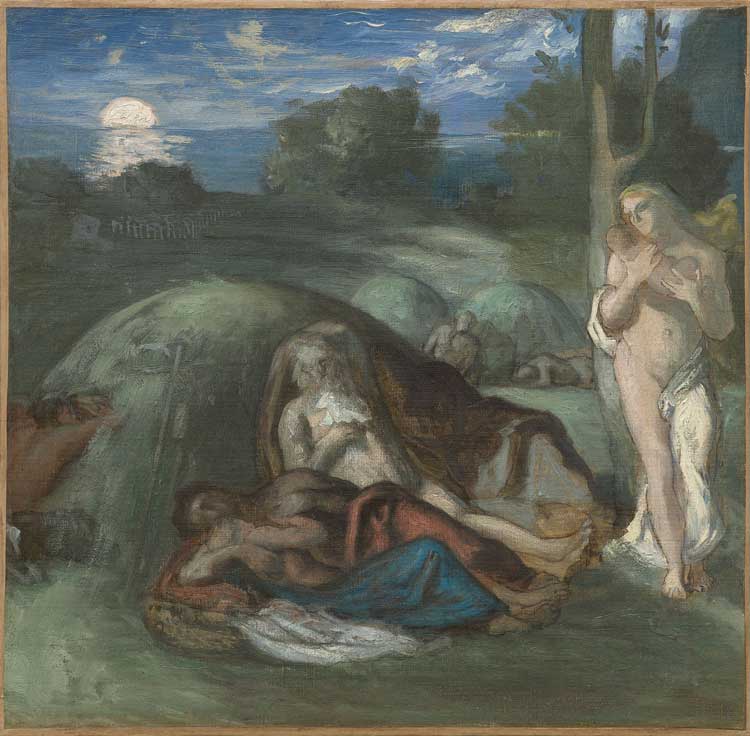
Pierre Puvis de Chavannes. Esquisse pour Le Sommeil
(Sketch for Sleep), 1867. Oil on canvas, 46.5 x 47.5 cm (18 1/4 x 18 3/4 in). © The Estate of Pierre Puvis de Chavannes. Courtesy Michael Werner Gallery.
The singular timelessness of Puvis’s distilled forms, rhythmic line and flat, chalky colouring of allegorical and classical subjects also fascinated Vincent van Gogh. In an 1890 letter to his sister Wilhelmina, he marvelled that with Puvis: “You cannot tell whether they are costumes of today or clothes of antiquity … You get the feeling of being present at a rebirth, total but benevolent, of all the things you have believed in, all you have longed for, a strange and happy meeting of distant antiquity with crude modernity.” But for all the consensus garnered in his own lifetime, it could be said that Puvis’s longevity did not match his contemporary influence on remarkably diverse artists.
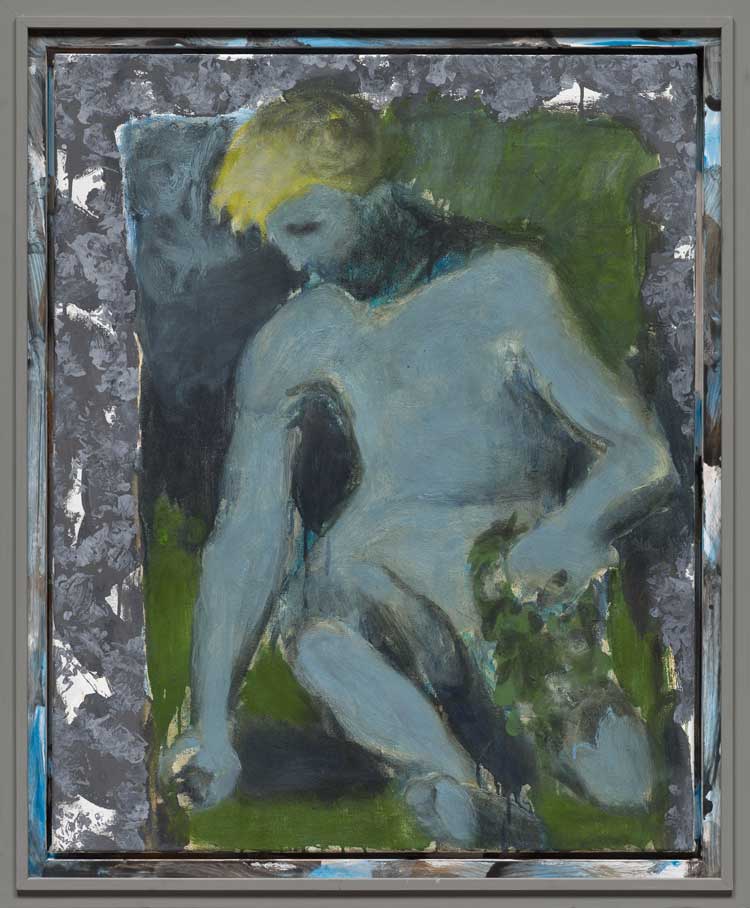
Markus Lüpertz. Narziss II (Narcissus II), 2016. Mixed media on canvas in artist's frame, 100 x 81 cm (39 1/4 x 32 in). © Markus Lüpertz. Courtesy Michael Werner Gallery.
The German painter Markus Lüpertz (b1941, Liberec) has been responding to the work of Puvis since 2011 and on display in this exhibition are works spanning the years 2013-23. In addition to painting, Lüpertz is also an educator, sculptor, jazz pianist, poet and publisher of the divertingly named magazine Frau und Hund. Lüpertz has conversed with other, predominantly, but not exclusively, 19th-century painters, including Jean-Baptiste-Camille Corot, Gustave Courbet, Francisco Goya, Nicolas Poussin and Hans von Marées, relating to them, he has said, “as if they were alive”. The focus throughout this exhibition is on the essential classical subjects of figure and landscape, and the relationship between the two.
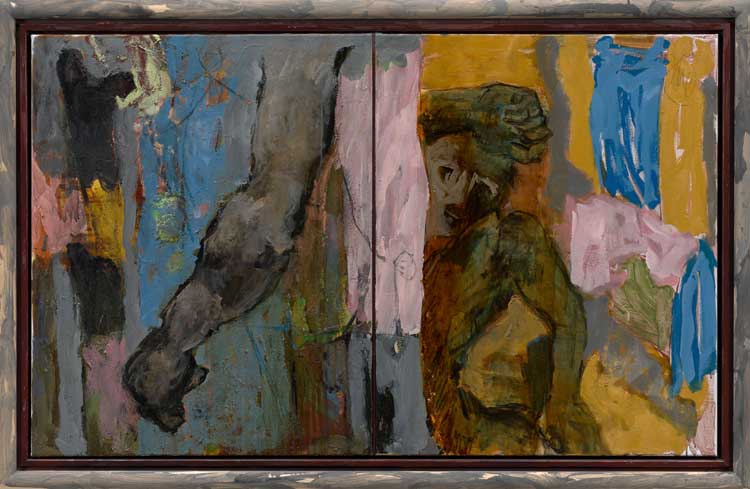
Markus Lüpertz. Student, 2020. Mixed media on canvas in artist’s frame, Two parts, overall: 100 x 163 cm (39 1/4 x 64 1/4 inches). © Markus Lüpertz. Courtesy Michael Werner Gallery.
Lüpertz is not coy about his interest in Puvis, at times even citing him in his titles, though he is not too literal in his formal interventions. The title of the large diptych Student (2020) is a suggestive indication of how he views his relationship with Puvis, and the composition directly cites two figures from the latter’s Saint Genevieve as a Child in Prayer (1879), painted for the Panthéon and represented in this exhibition in an exquisite Étude d’un Bras (Étude pour Sainte Geneviève, Enfant, en Prière) (Study of an Arm (Study for Saint Genevieve as a Child in Prayer) c 1877-1878).

Pierre Puvis de Chavannes. Étude d’un bras (étude pour Sainte Geneviève, enfant, en prière) (Study of an Arm [Study for Saint Genevieve as a Child in Prayer])”, c1877-78. Pencil, charcoal, chalk on transfer paper, 63 x 47 cm (24 3/4 x 16 1/4 in). © The Estate of Pierre Puvis de Chavannes. Courtesy Michael Werner Gallery.
Besuch von Pierre (Visit from Pierre) (2018) is a response to Puvis’s best known work, Le Pauvre Pêcheur (The Poor Fisherman) (1881), an unfathomably hypnotic scene, with its awkward, disconnected figures and morbidly glaucous colouring. Of the work’s desolation, Puvis remarked: “My only excuse is that I borrowed this vision of misery only from myself.” (A tiny yet captivating sketch of the work is present in the exhibition.)
Lüpertz’s rejoinder removes the fisherman and figures entirely, with only the boat remaining and an odd still life on a ledge near the picture plane that disrupts our view of the main scene: a peculiar vanitas containing an artist’s palette, a barely recognisable skull and, jarringly within this quasi-classicising realm, a soldier’s helmet – far from the first time he has incorporated military emblems of Germany’s National Socialist past into his images.
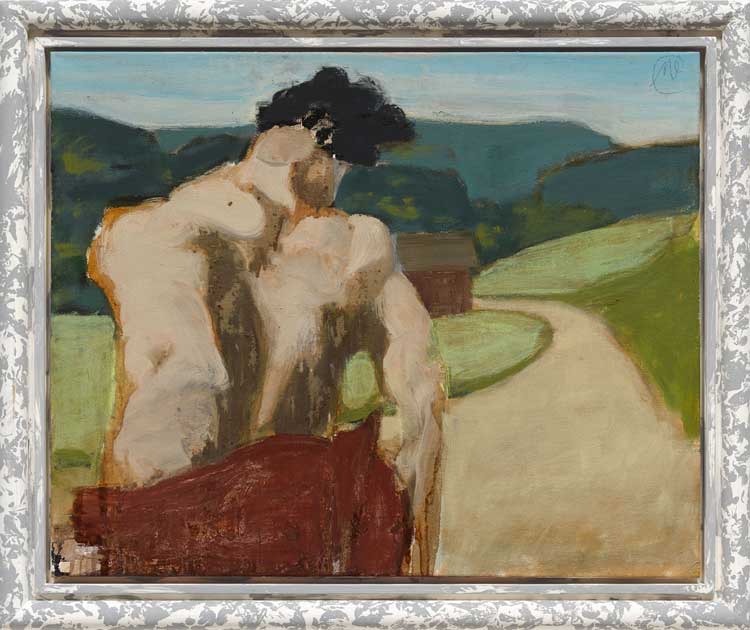
Markus Lüpertz. Rotes Boot (Red Boat), 2013. Mixed media on canvas in artist’s frame, 81 x 100 cm (32 x 39 1/4 in). © Markus Lüpertz. Courtesy Michael Werner Gallery.
The boat reappears in Rotes Boot (Red Boat) (2013) and Nacht (Night) (2013), here, too, with a deathly allusion in the form of a back view of a contrapposto male figure said to represent Charon, Greek mythology’s ferryman to the underworld. But knowledge of such references is not crucial to inhabiting the environments of Lüpertz, whose real concern appears to be representation itself, painting for painting’s sake. Rotes Boot and Nacht are a direct citation of Puvis’s marvellous, and unusually assertive, Homme Debout de Dos (Man, Back View) (1879-82), which hangs between them here, but while the latter is finely modelled in keeping with an orthodox classical language, Lüpertz’s handling of paint and form is wantonly ungainly, unconstrained by convention and more of a site of self-expression.
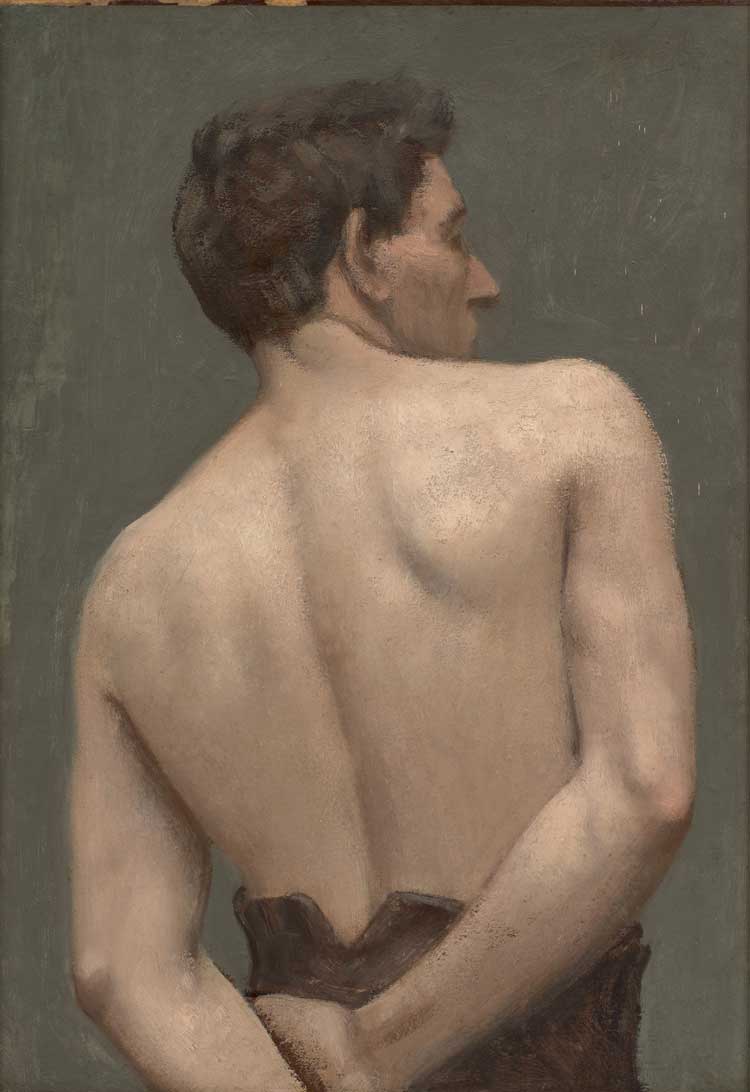
Pierre Puvis de Chavannes. Homme debout de dos (Man, Back View), c1879-82. Oil on canvas, 65 x 45.5 cm (25 1/2 x 18 in). © The Estate of Pierre Puvis de Chavannes. Courtesy Michael Werner Gallery.
His intent seems to lie, above all, in understanding how, and how far, the ideals of classicism can still be reinterpreted, or foiled and refuted, in a contemporary age, artistic homages as investigations of the history of art itself, above and beyond subject matter.
In Russisch Grün (Russian Green) (2020), for example, Lüpertz has superimposed a jarringly flat vivid green rectangle, approximating a modernist abstract canvas, on to a pastoral idyll with a female nude, in this case modern art truculently wiping out its classical antecedents on the picture plane. A similar effect is achieved in Caput Mortuum (Dead Head) (2022), in which a palpable, rusty brown rectangle partly shields the more androgynous nude and the trees’ branches, a consoling Arcadia once again interrupted, with another deathly reference in the work’s title.
Part of Lüpertz’s sometimes antagonistic relationship with Puvis consists of subtraction, whether of detail or clear structure, as well as abstraction. In several works, faces are erased and figures pushed to the edges of the picture, some further disrupted by Lüpertz’s self-made, splodgily daubed, camouflage-like frames, as if reluctant to have the image bounded at all.
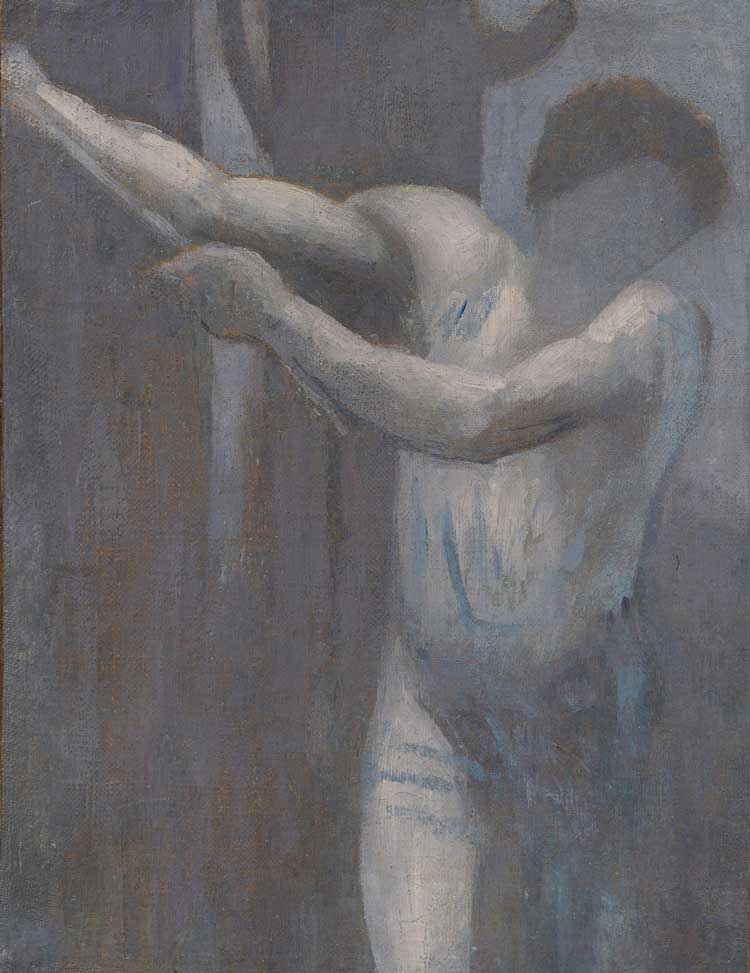
Pierre Puvis de Chavannes. Esquisse pour Le Bûcheron (Sketch for The Woodcutter), 1892. Oil on canvas, 35 x 27 cm (13 3/4 x 10 3/4 in). © The Estate of Pierre Puvis de Chavannes. Courtesy Michael Werner Gallery.
But Puvis, too, obfuscates figures, faces and landscapes, particularly in some of his preparatory studies and watercolours – well represented here – and it is in these images that the stilted allure of much of his finished work gains life. This is also where the two artists, in some instances so different, start to resemble one another much more, for example in Puvis’s obscure Le Bûcheron (The Woodcutter) (1892) and Homme Aveugle et Enfant (Blind Man and Child) (1850-55).
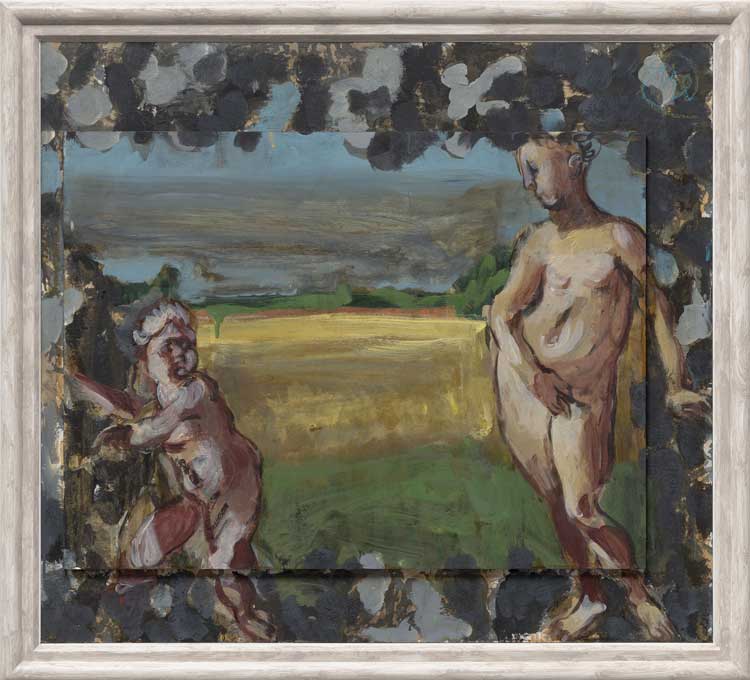
Markus Lüpertz. Amor + Psyche, 2020. Mixed media, collage on press board in artist’s frame, 82 x 92 cm (32 1/4 x 36 1/4 in). © Markus Lüpertz. Courtesy Michael Werner Gallery.
In the realm of contemporary exhibitions, the “dialogue” model can seem contrived, at times entirely unconvincing, but in this compelling exchange there is a kinetic sense of Lüpertz’s claim that he relates to artists of the past as if they were alive. Scanning the gallery walls, occasionally the identity of the artist momentarily eluded me, testament to painting’s vital ability to regenerate through the interventions of successive painters.
Complex, multilayered paintings and sculptures reek of the dark histories of slavery and colonialism...
Shown in the context of the historic paintings of Dulwich Picture Gallery, Rachel Jones’s new pain...
William Mackrell – interview: ‘I have an interest in dissecting the my...
William Mackrell's work has included lighting 1,000 candles and getting two horses to pull a car. No...
Marina Tabassum – interview: ‘Architecture is my life and my lifestyle...
The award-winning Bangladeshi architect behind this year’s Serpentine Pavilion on why she has shun...
A cabinet of curiosities – inside the new V&A East Storehouse
Diller Scofidio + Renfro has turned the 2012 Olympics broadcasting centre into a sparkling repositor...
Plásmata 3: We’ve met before, haven’t we?
This nocturnal exhibition organised by the Onassis Foundation’s cultural platform transforms a pub...
Ruth Asawa: Retrospective / Wayne Thiebaud: Art Comes from Art / Walt Disn...
Three well-attended museum exhibitions in San Francisco flag a subtle shift from the current drumbea...
This dazzling exhibition on the centenary of John Singer Sargent’s death celebrates his versatile ...
Through film, sound and dance, Emma Critchley’s continuing investigative project takes audiences o...
Rijksakademie Open Studios: Nora Aurrekoetxea, AYO and Eniwaye Oluwaseyi
At the Rijksakademie’s annual Open Studios event during Amsterdam Art Week, we spoke to three arti...
AYO – interview: Rijksakademie Open Studios
AYO reflects on her upbringing and ancestry in Uganda from her current position as a resident of the...
Eniwaye Oluwaseyi – interview: Rijksakademie Open Studios
Eniwaye Oluwaseyi paints figures, including himself, friends and members of his family, within compo...
Nora Aurrekoetxea – interview: Rijksakademie Open Studios
Nora Aurrekoetxea focuses on her home in Amsterdam, disorienting domestic architecture to ask us to ...
Kiki Smith – interview: ‘Artists are always trying to reveal themselve...
Known for her tapestries, body parts and folkloric motifs, Kiki Smith talks about meaning, process, ...
Frank Auerbach, Britain’s greatest postwar painter, has a belated German homecoming, which capture...
How Painting Happens (and why it matters) – book review
Martin Gayford’s engrossing book is a goldmine of quotes, anecdotes and insights, from why Van Gog...
Jonathan Baldock – interview: ‘Weird is a word that’s often used to...
As a Noah’s ark of his non-binary stuffed toys goes on show at Jupiter Artland, Jonathan Baldock t...
Helen Chadwick: Life Pleasures
Helen Chadwick’s unwillingness to accept any binary division of the world allowed her to radically...
Catharsis: A Grief Drawn Out – book review
To what extent can the visual language of grief be translated? Janet McKenzie looks back over 20 yea...
Radical Software: Women, Art & Computing 1960-1991
With more than 100 works by 50 artists, this show examines the pioneering role of women in computer ...
Dame Jillian Sackler, the art lover and philanthropist, has died aged 84...
Giuseppe Penone: Thoughts in the Roots
With numerous works created with the twigs, leaves, roots, branches and majestic forms of trees, thi...
Solange Pessoa: Pilgrim Fields
An olfactory orgy of marigolds, chamomile, grasses, sheepskins and kelp is arranged into a surreal l...
Christian Krohg: The People of the North
A key figure in Norwegian art, naturalist painter Christian Krohg wanted his art to bring social cha...
This comprehensive show charts the groundbreaking rise of the illustrated poster in 19th-century Fra...
Caspar David Friedrich: The Soul of Nature
This comprehensive show celebrating last year’s 250th anniversary of the Romantic painter’s birt...
A humongous survey of contemporary painting in Belgium shows a medium embracing the burden of its hi...
A retrospective of the first 20 years of the Max Mara Art Prize for Women finds an inexhaustible wel...
This new work is very much about indeterminate selfhood as Nora Turato immerses the visitor in a swi...
Burmese artist Htein Lin has been jailed many times and this show includes some of the remarkable pa...